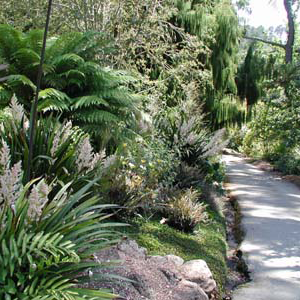 Plants in this collection are native to New Zealand, the mediterranean-climate and subtropical regions of Australia, and the high elevations of the South Pacific islands.
Plants in this collection are native to New Zealand, the mediterranean-climate and subtropical regions of Australia, and the high elevations of the South Pacific islands.
As in coastal California, southwestern Australia has a mediterranean climate, characterized by moderate temperatures, rainy winters, and long dry summers. Plants that have adapted to these conditions form the dominant vegetation types in Australia. Members of the myrtle, protea, and pea families are prominent in this flora.
The islands of New Zealand have year-round rainfall and a temperate climate. Evolution in the extreme geographic isolation of these islands has resulted in 75% of the plants being unique (endemic) to New Zealand. Ferns and conifers are prominent in this flora and are featured in the collection.
Many Australian plants thrive in California gardens due to similarities in climate. The moderate San Francisco Bay Area climate also favors New Zealand plants, though many need additional water in summer.
Many members of these floras, such as podocarps and southern beech (Nothofagus species) have close relatives in South America or South Africa. Their ancestors are found in the fossil record of the southern supercontinent Gondwana, which began breaking up 130 million years ago.
The northern end of the Australasian Area represents the moderately wet, warm temperate to subtropical rainforests of the North Island of New Zealand and southeast Australia. The southern end of the collection is suggestive of more xeric (drier) habitats, though nearly every plant featured in this collection is tolerant of wet conditions and so is able to survive in our heavy clay soils. As you walk through the Australasian Area from north to south, notice the shift in terrain from tall, wet forest to drier, low scrubland.

